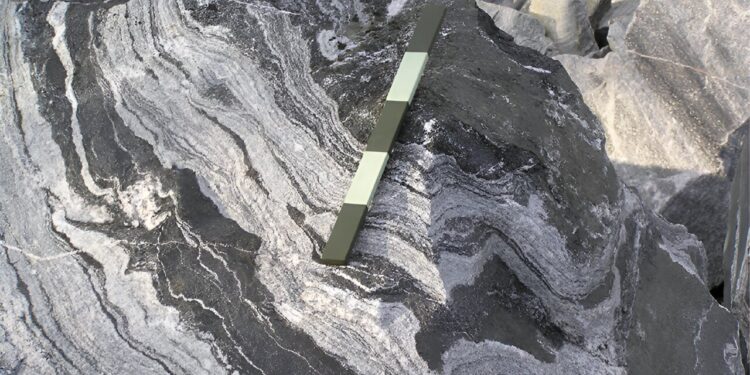The building blocks of the first continents are made up of three types of granitoid rocks: tonalite, trondhjemite and granodiorite (TTG). Credit: Jaana Halla
Geoscientists have discovered a missing link in the enigmatic history of continental development: a revised origin story that does not require the onset of plate tectonics or any external factors to explain their formation. Instead, results published last week in Natural communications rely solely on internal geological forces that occurred within the oceanic plateaus formed during the first hundreds of millions of years of Earth’s history.
A major obstacle to understanding the formation of continents during the Archaean Eon (4 to 2.5 billion years ago) has been the identification of the constituent elements of the early Earth’s crust. Much of the “new” Archean crust formed during this period included a very distinct association of three granitoid rock types: tonalite, trondhjemite, and granodiorite (TTG).
Understanding what contributed to the making of TTGs and the magmas from which they formed has been difficult, because many geological processes occurred between their initial melting and final crystallization. Previous researchers have focused on the trace element composition of these rocks, hoping to find clues to the TTG magmas and their source.
“We tracked a specific set of trace elements that are unaffected by alteration and perfectly preserve the signatures of the original magma that formed the new TTG crust,” said Dr. Matthijs Smit, Associate Professor and Full Professor. of the Canada Research Chair at the University of British Columbia (UBC) Department of Earth, Ocean and Atmospheric Sciences. “These features allowed us to examine the chemical changes undergone by TTG magmas and trace the melt compositions back to their initial state and source, most likely some sort of gabbro.”
“Surprisingly, many people have varieties of this type of rock as kitchen countertops,” says Dr. Smit. “In some ways, many people cook their dinner on the type of rock that gave rise to our modern continents.”
Much of the continental crust formed during the Archean Eon is still part of the continents today, as seen in the Rocky Mountains of Banff National Park, Canada. Credit: Gorgo
The Archaean TTG crust is still part of the continents today. For example, in North America, they make up a large part of the interior of Canada, between the Cordillera mountain belt in the west and the Grenville and Appalachian mountain belt in the east. The majority of Ontario, Quebec, Manitoba, Saskatchewan, the Northwest Territories and Nunavut is made up of fragments of Archean crust dominated by TTG and their slightly younger and more evolved granitic counterparts.
“All of these rocks, and especially their combination, can be explained by the model we present,” Dr Smit said. “Our model is simple in which TTGs, along with the younger rocks with which TTGs are typically associated, arise from the slow burial, thickening, and melting of a precursor crust that likely resembled oceanic plateaus .The continental crust was destined to grow in the same way. It did, as it continued to sink deeper and the rocks at its base had no choice but to melt. In doing so, they manufactured the TTGs which proved a winning recipe for the survival and growth of the continent.
UBC researchers’ discovery of a self-sustaining “intra-crustal” mechanism for producing TTGs dispels the long-standing theory that Archaean TTGs form in Earth’s earliest subduction zones and mark the beginning of plate tectonics.
“There has always been a ‘chicken and egg’ question of which came first: the onset of plate tectonics or TTG magmatism to create new continental crust,” says Dr Smit. “We show that these things may in fact not be directly related. Recognizing the source rock type makes this jump possible and also eliminates the need for other mechanisms, such as meteorite impact, to explain the growth of the first true continents.”
The study by Dr. Smit and his UBC-based team used data from every TTG sample ever analyzed – samples of Archaean cratonic fragments exposed around the world and scrutinized by researchers over the past 30 years . This allowed Dr Smit and his team to filter out local anomalies and analytical issues, and identify real compositional trends captured by the rocks. The study used a huge volume of data, now available in the open source geochemistry data repository of ocean and continental rock geochemistry hosted by the Georg-August-Universität in Göttingen.
More information:
Matthijs A. Smit et al, Archean continental crust formed from mafic cumulates, Natural communications (2024). DOI: 10.1038/s41467-024-44849-4
Provided by University of British Columbia
Quote: Researchers discover the source rocks of the first true continents (January 31, 2024) recovered on January 31, 2024 from
This document is subject to copyright. Except for fair use for private study or research purposes, no part may be reproduced without written permission. The content is provided for information only.



